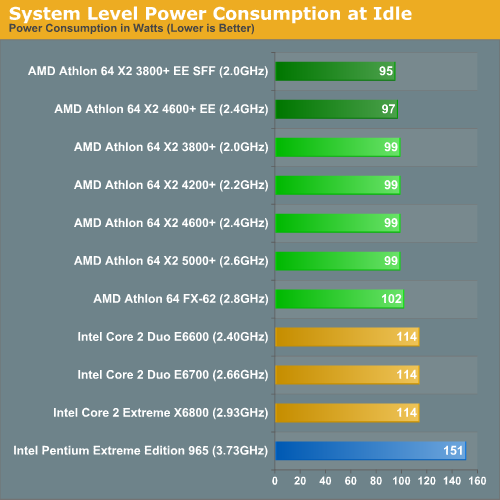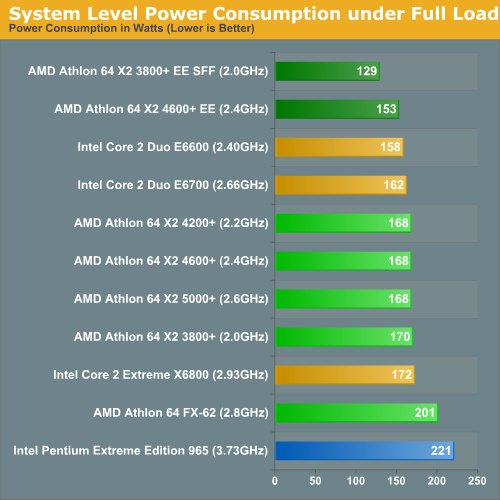Intel's Core 2 Extreme & Core 2 Duo: The Empire Strikes Back
by Anand Lal Shimpi on July 14, 2006 12:00 AM EST- Posted in
- CPUs
Power Consumption: Who is the king?
Intel promised us better performance per watt, lower energy consumed per instruction, and an overall serious reduction in power consumption with Conroe and its Core 2 line of processors. Compared to its NetBurst predecessors, the Core 2 lineup consumes significantly lower power - but what about compared to AMD?
This is one area that AMD is not standing still in, and just days before Intel's launch AMD managed to get us a couple of its long awaited Energy Efficient Athlon 64 X2 processors that are manufactured to target much lower TDPs than its other X2 processors. AMD sent us its Athlon 64 X2 4600+ Energy Efficient processor which carries a 65W TDP compared to 89W for the regular 4600+. The more interesting CPU is its Athlon 64 X2 3800+ Energy Efficient Small Form Factor CPU, which features an extremely low 35W rating. We've also included the 89W Athlon 64 X2s in this comparison, as well as the 125W Athlon 64 FX-62.
Cool 'n Quiet and EIST were enabled for AMD and Intel platforms respectively; power consumption was measured at the wall outlet. We used an ASUS M2NPV-VM for our AM2 platform and ASUS' P5W DH Deluxe for our Core 2 platform, but remember that power consumption will be higher with a SLI chipset on either platform. We used a single GeForce 7900 GTX, but since our power consumption tests were all done at the Windows desktop 3D performance/power consumption never came into play.
We took two power measurements: peak at idle and peak under load while performing our Windows Media Encoder 9 test.

Taking into consideration the fact that we were unable to compare two more similar chipsets (we will take a look back at that once retail Intel nForce 5 products hit the shelves), these power numbers heavily favor Intel. The releative power savings over the Extreme Edition 965 show just how big the jump is, and the ~15% idle power advantage our lower power AMD motherboard has over the Intel solution isn't a huge issue, especially when considering the performance advantage for the realtively small power investment.

When looking at load power, we can very clearly see that AMD is no longer the performance per watt king. While the Energy Efficient (EE) line of X2 processors is clearly very good at dropping load power (especially in the case of the 3800+), not even these chips can compete with the efficiency of the Core 2 line while encoding with WME9. The bottom line is that Intel just gets it done faster while pulling fewer watts (e.g. Performance/Watt on the X6800 is 0.3575 vs. 0.2757 on the X2 3800+ EE SFF).
In fact, in a complete turn around from what we've seen in the past, the highest end Core 2 processor is actually the most efficient (performance per Watt) processor in the lineup for WME9. This time, those who take the plunge on a high priced processor will not be stuck with brute force and a huge electric bill.










202 Comments
View All Comments
defter - Friday, July 14, 2006 - link
Xbitlabs has a great E6300 review:http://www.xbitlabs.com/articles/cpu/display/core2...">http://www.xbitlabs.com/articles/cpu/display/core2...
Overclocking was limited by a motherboard, but they still managed to achieve 2.94GHz with 420MHz FSB, not bad from a <$200 chip. E6300@2.94GHz was way faster than Athlon64X2@3GHz.
Frackal - Friday, July 14, 2006 - link
4ghz Conroe, holy shiatAndrewChang - Friday, July 14, 2006 - link
Loved the title, and loved the article. Can't wait till the Return of the Jedi...JackPack - Friday, July 14, 2006 - link
Jedi is considered to be weakest film of the three....formulav8 - Friday, July 14, 2006 - link
Yeah, but the Emperor WAS overthrown. :)Anyways, good job on the review. Intel is definitely trying to almost GIVE those PD cpu's away it seems. $93? Not that I don't blame them. They would almost HAVE to give them away to get rid of them.
Jason
haugland - Friday, July 14, 2006 - link
Page 18:According to the prices on page 2, the price for the 2.4GHz E6600 is $316, while the 2.13Ghz E6400 costs $224.
mobutu - Friday, July 14, 2006 - link
I quote:"The 2.4GHz E6600, which outperformed the FX-62 in most benchmarks at stock speed costs $223, and overclocked to 4Ghz with excellent air cooling"
It costs $316 according to Intel charts. Please fix it.
10x
JarredWalton - Friday, July 14, 2006 - link
Fixed (also for post below).mi1stormilst - Friday, July 14, 2006 - link
I was like skimming throught the article and thinking to myself wow. Then I went back and looked at the benchmarks and realized that until I see benchmarks with a wider range of video card and cpus I will reserve my excitement. At the moment my $120.00 used 3200 venice running at 2600MHZ with an X1800XL gives me some very good performance.JarredWalton - Friday, July 14, 2006 - link
I http://www.anandtech.com/guides/showdoc.aspx?i=279...">looked at performance with several CPUs using a 7600 GT (slower than X1800XL, but not by a huge amount). Basically, on lower end GPUs you will be GPU limited and just about any fast CPU. Maybe not always with NetBurst, but K8 and Core2 will be more than sufficient for all but multi-GPU setups (until next gen GPUs arrive).